Editor’s Corner
This month’s issue of FitITproNews is full of lots of terrific stuff that can help “recovering fat IT pros” like ourselves (me, anyways) make progress in metamorphosizing themselves into lean and energetic “fit IT pros”. Plus we also have an Ask Our Readers item from Yours Truly in this week’s newsletter that I would appreciate any help with you readers can provide by sending me some suggestions and comments to [email protected] — thanks!
In this month’s issue you’ll also find the following articles by our FitITproNews columnists:
- Robin Camp on Improvising, Adapting and Overcoming.
- Rod Trent on How to Find Running Paths While Traveling.
- Mark Nichols on Don’t Regret the Holidays!
- Kris Lall on The Creed Need.
- Brian Dougal on Let’s discuss the stress in your life!
- Yuri Diogenes on The Journey to Achieve Strength and Conditioning.
- Kris Kane on What gets measured gets managed!
- Lana Khazari (NEW!) on 5 tips from someone who has kept the weight off.
Also be sure to check out our BLACK FRIDAY DEALS below for some terrific deals from Amazon on fitness and exercise equipment, health and nutrition products, and more exciting deals for recovering fat IT pros like ourselves!!
Don’t forget, if you have any comments or suggestions concerning the stuff in this week’s newsletter, email me at [email protected] and we’ll share your feedback in the Mailbag section of our next newsletter. And if you’re an IT professional who is also pursuing fitness or has had success in losing weight and you’d like to become one of our columnists you can reach out to me at [email protected].
In the meantime enjoy this week’s issue of FitITproNews!
Cheers!
Mitch Tulloch, Senior Editor

Mitch Tulloch is the Senior Editor of FitITproNews and a recovering fat IT pro who lost 50 lbs in midlife and is now on his way to becoming a fit IT pro. Mitch is a widely recognized expert on Windows Server and cloud technologies who has authored or been Series Editor of numerous books/ebooks from Microsoft Press. Mitch is also the Senior Editor of WServerNews and writes frequently for TechGenix.
BLACK FRIDAY DEALS!!!
The following are paid links that TechGenix will earn a commission through any qualifying purchases made using them.
Fitness and Exercise Equipment DEALS!!
Medical Exercise Bike Pedal Exerciser Mini Peddler for Leg and Arm Cycling Exercise
Mgaolo Fitness Tracker HR,Smart Watch Montre Intelligente Activity Tracker with Adjust Brightness Screen,IP68 Swimming Waterproof Fit Wristband Pedometer with Heart Rate Sleep Monitor for Android & iPhone
Soges Multi-Functional Dumbbell Bench Adjustable Height Incline Bench, Multi-Workout Abdominal/Hyper Back Extension Bench, Home Strength Training Fitness Workout Station
Cap Barbell Standard Bench, Black
Marcy Adjustable Olympic Weight Bench with Leg Developer and Squat Rack MD-879
Health and Nutrition DEALS!!
Renew Life Ultimate Flora Critical Care Go Pack, Probiotic, 50 Billion Capsule, 20 Count
Easy@Home Digital Wrist Blood Pressure Monitor (BP Monitor) with Pulse Meter and Backlit Large Display, EBP-017
Evlution Nutrition CLA 1000, Conjugated Linoleic Acid, Weight Loss Supplement, Metabolism Support, Stimulant-Free (180 Servings)
Biosteel High Performance Sports Drink Powder, Naturally Sweetened with Stevia, Lemon Lime, 700 Gram
QardioBase2 WiFi Smart Scale and Body Analyzer: monitor weight, BMI and body composition, easily store, track and share data. Free app for iOS, Android, Kindle. Works with Apple Health – Black
More exciting DEALS!!!
WiFi Extender Blast, Wireless Internet Booster for Home 300Mbps Long Range WiFi Repeater WLAN Signal Amplifier, 2.4GHz Network Mini WiFi Router for Phone/Computer/Smart TV and More
Ohuhu Adjustable Vented Laptop Table Computer Desk Portable Bed Tray Book Stand Multifuctional & Ergonomics Design Dual Layer Tabletop with Cooling Fun(Black)
Mini PC,Intel x5-Z8350 HD Graphics Fanless Mini Computer,Windows 10 64-bit,4GB/64GB Storage/4K/Dual Band WiFi AC/BT 4.2/1000Mpbs Ethernet
Subscribe to FitITproNews!
Subscribe today to our FitITproNews newsletter and join 200,000 other IT professionals around the world who receive articles, stories, and tips on exercise and nutrition that can help you transform yourself from a fat IT pro to a fit IT pro! Just go to this page and select FitITproNews to receive our monthly newsletter in your inbox! You can also find the latest issues of our newsletter online at fititpronews.com while issues from our first two years can be found in our old archive.
Disclaimer: I am not a certified fitness professional or nutritionist so take any suggestions made here “as is” with a grain of salt and a heaping supply of your own judgment. Please read our full disclaimer at the bottom of this newsletter.
Send us your feedback!
Got feedback about anything in this issue of FitITproNews? Email us at [email protected] today!
Meet my new friend (Mitch Tulloch)
A few weeks ago we invited my new friend to come and live in our basement where I do my workouts most mornings of the week. My friend asked me to take a photo, so here it is:
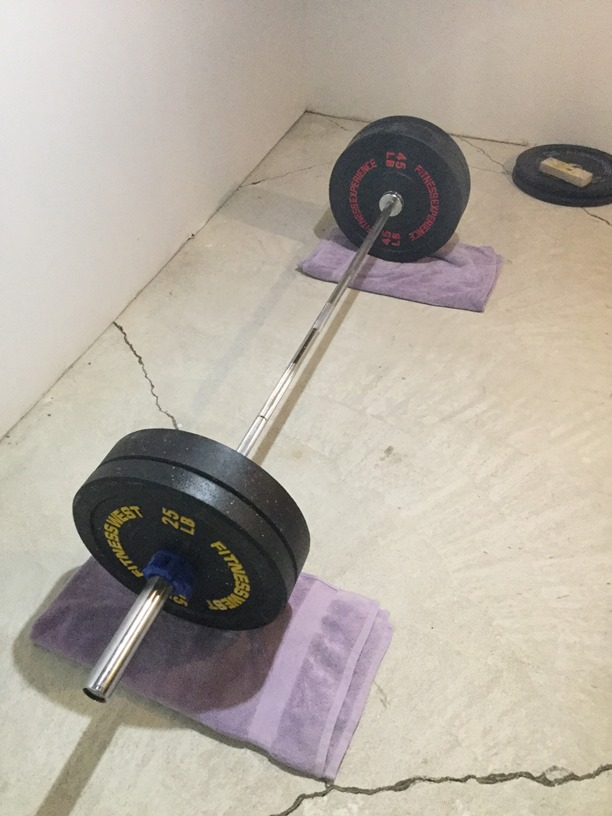
Yes, I’ve finally built up enough strength using heavy dumbbells to graduate to including a few barbell exercises in my strength routines.
Dumbbells are great for building up a basic level of strength if you started out as a 93 pound weakling — or a 250 pound fat IT pro which is where I started out myself ten years ago as a dangerously unhealthy fat IT pro. Having never exercised a day in my life until then — unless you count lifting and moving around chess pieces as exercise, which was the only “sport” I was involved with during my school and university days — my first foray into working out involved swinging a pair of green rubber-covered 5 lb dumbbells. And I got sore arms doing it!
Now that I can easily perform multiple sets of deadlifts, curls, bent over rows and other exercises using 40 lb dumbbells however, I decided it’s probably about time I tried using a barbell to see if I can take my strength to the next level. Even though the next level for me is something far less than what some of our columnists like Brian Dougal and Yuri Diogenes can accomplish without even breaking a sweat 😉
But anyways, each to his own. My goal isn’t to become a bodybuilder or win contests, it’s simply to improve my overall health by increasing musculature and lowering bodyfat. And strength training I’ve heard is a key part of achieving such goals, along with a good measure of high-intensity cardio.
As far as deciding which kind of barbell to buy, I decided to go with an inexpensive bar and bumper plates. The bar has bushings, not bearings, which means it’s not suitable for doing advanced (i.e. Olympic) lifts such as the Snatch or the Clean and Jerk. And using bumper plates means I won’t be able to put too many plates on the bar, but I’ll probably never get beyond having two 45 lb plates on each side which would make for a total loaded bar of 225 lbs. There’s no reason I can think of that I’d want to go heavier than that at this stage of my life.
Anyways, my next few articles in FitITproNews are going to focus on how I am starting to incorporate barbell exercises into specific kinds of strength workouts that I’m currently doing, namely workouts that focus on the posterior chain, pushing exercises, and pulling exercises — all basic stuff that builds strength that can carry over easily into all kinds of sports and also daily activities such as moving stuff around the house or office and so on.
Wish me luck! And that I take it slow and gradual so I don’t get derailed early on by an injury.
Cheers,
Mitch Tulloch
Email your questions and comments to me at [email protected]
Ask Our Readers: How to properly perform a deadlift
Deadlifts, squats and bench presses are said to be the core exercises for building a strong body. I don’t have a squat rack yet so I can’t do squats, and I don’t own a bench either so bench presses are out.
That leaves deadlifts, and I’m a beginner at how to do these properly. Do any of you readers out there do deadlifts using barbells? What kind of advice would you give to a beginner like me so I do them properly and avoid getting injured? I’ve done some research already about this by looking at various websites and videos, but the advice by these “experts” tends to vary quite a bit.
What I’d like is some good advice about things like:
- Foot placement (width and angle)
- Hand placement on bar
- Muscle activation in legs and back
- How to pace repetitions
- Rest period between sets
- Breathing
- Anything else?
Can any of you readers suggest anything about these? Email me at [email protected]
Thanks!!
Exercise Tip: Loosen up after working out (Mitch Tulloch)
After a heavy muscle workout you should release tension from your musculature by shrugging your shoulders, performing hip circles, and shaking out your arms and legs. These are also good exercises to perform frequently if you sit a lot at work or spend lots of time driving in your car–or watching TV or playing videogames on your couch!
Improvising, Adapting and Overcoming (Robin Camp)
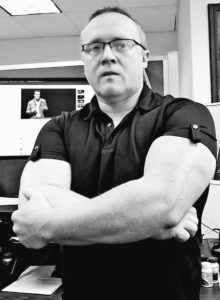
Robin Camp works as tech support for an Orthodontic Practice Management Software company called New Horizons Software ( www.nhsoftware.com). As a professional photographer on the side, Robin does fashion, glamour weddings and more in his spare time (www.dancingwithlightphoto.com). You can also now find him working out on Instagram at https://www.instagram.com/fitittech/.
Three years and less than a month away from my goal achievements, I had an accident in the gym. Argh! Totally knew better, but slipped in sweat doing a deadlift and instead of dropping the weight I tried to catch the weight and myself. Catching 500 lbs. as it falls and being off balance does not equal a happy body. Tore my SI joint (joins the sacrum and the ilium-the tailbone and the hipbones) also tore a glute and hamstring.
So, instead of trying to up my PR for deadlift from 595 to 600, it’s time to rethink training. I can’t do any lower body stuff for the next two-six months. There goes my squat. Can’t do crunches, there goes my core progress. Half my workout is forbidden by the therapist, so after a couple days of wanting to punch a wall out of frustration I sat down gingerly and began a new workout plan, just because I can barely walk, doesn’t mean I have to give up on my fitness, I just need to adapt, instead of focusing on what I COUDN’T do, I had to focus on what I COULD. The distance I go, to come up with new article material for y’all!
I can work on my hip mobility, within reason, something that has hampered my squat and made sitting for extended periods of time painful. I can do some limited Yoga work that I have been neglecting, Cobra pose, Child pose, some careful hamstring stretches and quad stretches.
I can do twenty minute walks on the treadmill (need a flat non potholed surface) so much for a 5k this month.
Mon, Wed, Fri:
Shoulders and arms and traps, time to get some definition going!
Shoulders:
- Seated shoulders front raises-> 20-25 reps 3 sets
- Seated shoulder side raises-> 20-25 reps 3 sets
- Face Pulls for rear shoulders-> 20-25 reps 3 sets
- Seated Dumbbell Shrugs-> 20 reps- 3 sets
Arms:
- Rope press downs-> 40 reps 3 sets
- Rope curls-> 40 reps 3 sets
- Hammer Curls-> 20 reps 3 sets
- Rope Pulls behind head-> 40 reps- 3 sets
Mobility Stretches 10-15 minutes
20 minutes comfortable pace, no incline on treadmill.
Tues, Thurs:
Chest and back.
Chest- no heavy bench- Again goal here is get some definition going and to not lose my gains
- Close grip dumbbell presses-> 20 reps- 3 sets
- Dumbbell Fly’s-> 20 reps- 3 sets
Back-have to make sure back is straight-
- Seated 1 armed cable rows-> 20 reps- 3 sets
- Seated cable pull downs-> 20 reps- 3 sets
Mobility Stretches 10-15 minutes
20 minutes comfortable pace no incline on treadmill.
Final thoughts
Outside of the gym, I will have to be stricter on my diet, to adapt to the fairly lazy workout routine going from roughly 12 hours a week in the gym to 6 hours. I will also need to focus on consuming as many natural anti-inflammatory’s as I can to keep the swelling down and speed up recovery.
I hope this rambling helps some people out; as a very goal/results oriented person the injury was devastating and the only thing I could do mentally to pick myself up, was to figure out what I could do and reset my goals. Hopefully this helps anyone encountering setbacks. Stay safe and motivated!
How to Find Running Paths While Traveling (Rod Trent)

Professionally, Rod Trent is a PFE/STA for Microsoft, focusing on Azure Identity and Governance and EMS. Privately, Rod is dedicated to fitness through diet, running, and other activities, but also a TV and movie junkie. You can find Rod active on Twitter (http://twitter.com/rodtrent) and LinkedIn (https://www.linkedin.com/in/rodtrent/).
The term “Road Warrior” has been associated with a few different things over the years. Most consider it as describing an individual who travels a lot for work. But, in the runner world, it refers to a specific type of runner. This runner will not — for any reason EVER — run on a treadmill. They have a distinct aversion and oftentimes react snobbishly when addressing those that use the treadmill as a tool when an area is unsafe or weather is less than accommodating.
First…is it OK to run on a treadmill? Of course, it is. If that is the tool you have, use it. There’s nothing at all wrong with recording a run on a treadmill. Anything is better than nothing particularly for those constant travelers who have to work hard to make time to stay fit. Anyone that tells you different or tries to make you feel less of a runner for opting for an inside run, ignore them. Completely.
Traveling for work, I stay at some gorgeous locations. So, even if the weather is cold or rainy, I’ll try to get at least one run outside, taking what I call a “sight-seeing run.” This run is slow, and I stop often to take in the scenery and take lots of cool pictures to share.
So, how do you find good places to run when traveling? Here’s a couple tips that work for me…
- Pick the hotel based on area maps. I schedule my trips through my company’s travel partner, but I take great care to verify the area before I choose the hotel. I regularly open a second browser tab and look through the online maps for the surrounding area before selecting where I stay. I’ll even do street side views to make sure there’s sidewalks and local parks. So, if you have a choice where you stay in the area, pick one that’s best for a runner’s life.
- Ask the hotel. You’d be surprised to find how many runners are also work travelers and how many hotel staff are regularly asked about local places to run. I do this quite often myself. The staff are happy to help and I’ve had many pull out local paper maps from behind the check-in desk and draw routes with pens or permanent markers.
- Use technology. Most fitness devices have accompanying apps. Some (like my Garmin device) allow you to record, save, and share your own routes. Check to see if your device’s app has this feature. If so, you should have the option like I do with my Garmin to peruse the recording paths by the community. But also I have a couple mobile apps that I use regularly to locate running paths. The top app is AllTrails. Alltrails is both an app and website (www.alltrails.com) and it includes much more than just running trails. But, I use it to locate local area running trails and paths. AllTrails is available free, but there’s a pro version that gives you more features including the ability to download maps offline and enabling lifeline signaling (in case you get in trouble).
Hope that’s helpful!
Don’t Regret the Holidays! (Mark Nichols)

Mark Nichols is an IT professional that got started with VMS in 1984 and is now a Sales Engineer for a Global IT Software company and a CrossFit Level 1 Trainer with his local box.
They’re here. Every year, they roll around like clockwork, the changing of the seasons, and the turning of the calendar. Thanksgiving and Christmas are the most celebrated seasons of our culture. We celebrate with friends, family, football, and food, especially food!
And right after the holiday season is a gym owner’s favorite season, the season of resolutions. It is the time when we take stock of our lives and decide, “This year is going to be different, this will be the year I lose 10 lbs., or this will be the year I get in shape.”
It doesn’t have to be that way. We can start before the holidays. We don’t have to wait until January 1st to take care of ourselves. In fact, the more we look at the past, the more we may feel the pain of regret over how we let ourselves get to a bad place.
So how do we avoid post-holiday regret? I mean, who can say “no” to turkey, mashed potatoes, gravy, or pumpkin pie? Why would you want to say no?
The answer to the last question may be “January 1st.” Or the answer may be the way you will feel as you lay on the couch in a dazed, carbohydrate induced semi-coma, as a football game plays in the background.
When I chose to embrace the plant-based lifestyle and take care of my health, I knew that Thanksgiving and Christmas would be a big challenge, especially since I have a reputation for making a delicious turkey (I use Alton Brown’s recipe from ‘Good Eats’). My wife made it clear that I could eat anything I wanted for Thanksgiving as long as I cooked the turkey.
So I made a plan. I researched great plant-based, holiday-themed dishes that supported my health choices rather than compromised them. I found a stuffed acorn squash recipe that provided savory holiday flavors. I added my other holiday favorite vegetables like sweet potatoes, green beans, and corn. The results were excellent. The turkey was still a big hit for the rest of the family, and they even admitted that my stuffed acorn squash was worthy of an honorable mention.
Subsequent holidays haven’t always been as successful. My most significant weakness is desert, especially pumpkin pie. The first plant-based holiday, my plan included recipes that would not throw me into a sugar tailspin. However, through the years, I wandered into the territory of “just one slice of pumpkin pie.” Then, it would spiral into “just one slice” of every desert available until last year; I ate almost a whole pumpkin pie myself.
The key for me is to plan and make the commitment now before the holidays get here. I choose ahead of time what I am going to eat and when I am going to work out, realizing that my health is more important than a slice of pie. From experience, I know I can choose delicious food without compromising my health goals.
Now is the time, before someone sets the table, for you to plan. Commit to your choices and avoid regret. You are worth it.
The Creed Need (Kris Lall)

Kris Lall works as a product manager in the tech industry for an enterprise software manufacturer. As a youngster, Kris was consumed with soccer before technology came along. Now he’s consumed with both. You can find him on Twitter at the not-too-surprising handle @krisoccer.
Some people workout to build muscles in all areas of the body. Others focus on a specific area of the body or set of muscles. If you’ve ever seen Michael B. Jordan with his shirt off — and it’s not a far stretch, given how many movies he’s been in recently sans clothing — you’ve witnessed someone focused on building muscles in a specific area.
While the ladies have taken notice of Mr. Jordan’s physique, the lads have also taken notice, mostly because the lasses have. So after seeing the movie “Creed” starring Mr. Jordan, my son, Ben, a sophomore in college at Washington State University in Pullman and his fraternity brothers (Delta Sigs!) researched the workout routine Jordan followed for the movie to build his ripped upper body. The following represents a modified four-day workout routine that focuses mainly on the upper body:
Day 1: Focus on back and biceps
- Bent over rows
- Dumbbell curls
- Wide grip pulldown
- Single arm dumbbell row
- Seated cable row
- Pullups
- Machine curls
- Side curls
- Reverse flies
Here’s an example of how to perform bent over rows:
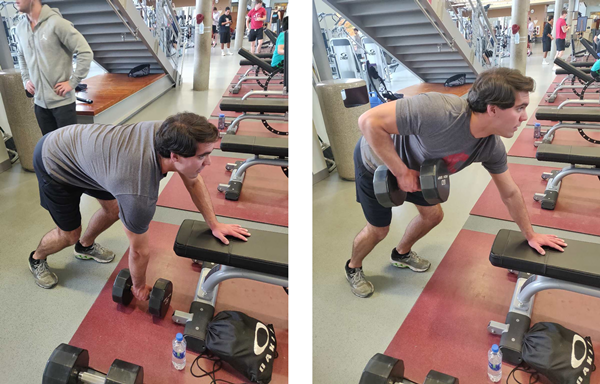
Day 2: Focus on chest and triceps
- Bench press
- Skull crushers
- Incline dumbbell bench press
- Close grip bench
- Triceps dumbbell kickbacks
- Seated overhead triceps dumbbell extension
- Leverage decline chest press
- Triceps rope press down
Day 3: Legs (give upper body a break)
- Squats
- Romanian dead lift
- Leg press machine
- Seated calf raise
- Seated leg curls
Day 4: Biceps, triceps, shoulders
- Dumbbell shoulder press
- Upright barbell row
- Standing barbell raise over head
- Reverse machine flies
- Dumbbell shrugs
The boys typically do 4 sets of 10 reps each with ascending weight and a descending number of reps. They workout 3-4 days per week for about 90 minutes, with alternating days of core and cardio (running, bike machine). And each workout ends with either a 10 minute run for cardio or core — sit ups, flutter kicks, and bicycle kicks. Further, they plan to change up their work out every 3 months or so to continue optimal tearing and rebuilding of the muscles.
What types results are the young men achieving? Ben weighed ~175 lbs. when he started and with added muscle now weighs ~184 lbs. in about 2 months of regular workouts. However, since it’s cold in Pullman this time of year, it looks like the men will have to wait till spring to exhibit their Creed-like chiseled torsos to the coeds and determine whether their investment brings about real world success.
Let’s discuss the stress in your life! (Brian Dougal)

Brian Dougal is an IT manager for Powder River Development, a father of five, a blitz-hobbyist, a table-top role player, and a health coach for the OptaVia Health Program. You can also find Brian on Instagram @dougalhealth.
Hey, IT Nerds, How’s your health? Let’s discuss the stress in your life.
How would you rate your stress levels? Does the stress in your life help you to complete tasks and meet deadlines, or is it causing you medical problems? Are you popping antacids every hour to keep your stomach under control? Do you have panic attacks when you think about an event coming up? Do you worry about EVERYTHING?
Stress doesn’t have to be a bad thing. It is a great motivator for making snap decisions in an emergency situation, help you meet deadlines, and warn you when a decision seems to be the wrong one.
But for the bad stress, the ones that cause worry, the ones that cause stomach issues, heart conditions, irritability, muscle tension, high blood pressure, and frequent colds or flu, those are the ones we need to learn to mitigate.
Cut Out the Stressors
We all have those things that we dread. For me, it was extra meetings. I was Sgt. At Arms in my local Disabled American Veterans chapter. Once per month I would go sit with a bunch of world war 2 and Korean war vets. A friend of mine got me involved. I gave it a year, but after that year, I started dreading those meetings. I hated the idea of taking off from my family for those 2 hours. So I cut it. I did the same thing with the other two groups that I was part of that took me away from my family. Those meetings have value, but at the time they were just causing me stress. Cut out the stressors.
Learn to Budget Your Time
Waiting until the last moment can cause large amounts of unhealthy stress. Saving the project for the last day, and then suddenly being under the time crunch, can feel like a great motivator to get it complete, but by better budgeting your time to do a little on your project each day until it’s complete, you may find that the quality of your project is better than the deadline crunch, and will reduce the stress in your life.
Pick Your Battles
At work, in your friend groups, at home. Pick your battles. My kids leave the living room a mess every time they hang out in there. Having an autistic son who doesn’t think anything is more important than his immediate desire is a huge stress for me as I walk behind him and put away the ketchup from his lunch sandwich, throw away the pop tart wrapper, and take his dishes to the sink. My twin toddlers destroy a room by pulling things out of the cupboards, flip over every box or basket, and unfold all the clothes that my wife and I folded while watching Travelers on Netflix the night before.
Upon coming home and seeing the mess, if I start yelling at kids to clean up the mess, berate my wife for not doing better at keeping up on the housekeeping, then the night is ruined. No one is happy, I’m sure not happy, and production (cleaning up) is low, because morale is low. If I just come home and take 15 minutes to straighten up a room, no one is crying, no one is stomping to their room and slamming doors, getting grounded, and often when I begin picking up they jump in to help me, and we have a nice evening.
Take Time Out
I like to take walks. My bank is about a half mile from work, so if I need to go to the bank I just walk. One day it had rained earlier, and the cloud forms were just right so there was a corona around the sun. A full rainbow all the way around the sun. I looked again and saw another ring, larger, a bit farther back, and then a full rainbow that went from horizon to horizon, like it would have been a third corona if there was enough room. It was incredible. I realized at that moment that I hardly ever looked around. I usually walked looking at the lines in the sidewalk (so as to adjust my steps and not step on them), but I didn’t take notice of the world around me and its incredible beauty.
Notice your shoulders. Right now. Stop what you’re doing and notice them. I’m betting they’re raised. You may not even realize it, but they’re raised. Relax them. Let your shoulders drop. Do you have to pee? Are you hungry? Does something hurt? Do you have to move because you’ve been sitting for far too long? Take note of your body and the way you feel.
Listen to the sounds around you. I hear voices at the end of the hall, the whisper of the HVAC system, the clacking of my keys on the keyboard, the thrumming of the fan in my computer. The buzz of my phone as notifications come in. Creaking of the floor as Steven walks down the hall to Meg’s office. There are so many things that happen around us that we don’t even notice.
Try Meditation
I used to have a problem with my brain being constantly full of random thoughts, so much that it kept me from focusing on anything. I couldn’t listen to my wife tell me about her day, because I was jumping to a different thought in my head every half second. Note I said “used to”. What helped was a book on meditation and learning to count.
Set aside a few minutes every day. Like 10. Download an app, plug in your ear buds, and relax.
Exercise and Yoga
One of the greatest stress relievers is the release of endorphins through exercise. It improves our mood, helps us to feel better, forget the stressors of the day, and builds our body as well. And exercise types like yoga, hiking, cycling, or running give us the opportunity to let our mind wander in a type of meditation as our body works, relieving stress, giving us that feel good high.
So take a quick examination of your stress levels and find some good ways to relieve them. Take up a hobby, sit on a cushion and relax, let those shoulders down, and find a good balance.
Next month we will go deeper into my favorite yoga routine.
The Journey to Achieve Strength and Conditioning (Yuri Diogenes)
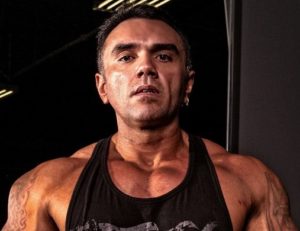
Yuri Diogenes is a Senior Program Manager for one of the biggest software companies in the world, author of the book Ready, Set, Achieve (www.readysetachievebook.com), amateur Bodybuilder and Brazilian Jiu-Jitsu fighter.
For five years (between 2013 and 2018) all my physical activity was dedicated to achieving a balanced physique in order to compete in the National Physique Committee (NPC), which is the amateur bodybuilding league in US. My diet and weight lift training was very focus on gain muscle, and when talking about condition, it was more around the staying lean, having muscle density and hardness. In 2019 I took off from the bodybuilding stage and started my journey in the BJJ (Brazilian Jiu-Jitsu) world. As a white belt, I quickly realized that my strength was only useful in the first two minutes of the roll (usually a roll has 5 minutes), after that I was gassing and basically powerless. Throughout the year, I worked a lot to gain real conditioning (not the one that we used to talk about in the bodybuilding world), this one is about cardiovascular conditioning, being able to stay actively engaged for 5 minutes in a roll is a lot, matte of fact, it is way easier to me to do one hour in the Stairmaster than two consecutives rolls of 5 minutes each.
In May this year I won the heavy weight (up to 222 lbs) division of the IBJJF Dallas Open — Spring Edition. It was great, but to be honest, my condition was not put in check mate, because I was able to submit my opponents in than two minutes. While this result is great, I really didn’t test how my gas was, and I knew it needed improvement. I decided to compete again in July in the IBJJF Austin Open — Summer Edition. I usually stay around 225 lbs in the offseason, and I cut to 215lbs to compete, so that when I weighed in with the Gi, I’m safe around 219lbs. But, for some reason, on this day, it didn’t work that well, and when I weighted in (30 minutes prior to the match), I was 2 lbs over with the Gi. That never happened to me, and I had to lose 2lbs in 20 minutes, it was crazy, but I did lose. I went to my first match and I won by points, but at the end of the match (5 minutes), I was destroyed, literally no gas left at all. I rested for 10 minutes prior to the finals, and although I started good, around 3 minutes I was done. I started to see things blurry and on couldn’t defend anymore. I lost the final by points and got second place.
There is no better way to access your weakness than when you lose, and off course I could blame the abruptly weight loss, which led me to dehydration and lack of gas. But, I had to think of two things:
- How to better manage my weight to avoid this to ever happen again
- How to improve my cardiovascular condition to be able to handle multiple rounds of five minutes if necessary
I established a new goal, compete in October at the IBJJF Houston Open — Fall Edition. I worked with my personal trainer (Greg McCoy) in a diet that was around 2100 calories (60% protein, 20% fat and 20% carbs), we add lots of HIIT (High-Intensity Interval Training) in my workout routine, and BJJ drills, such as this one that published on Twitter. But, I didn’t want to lose strength either, so we added some heavy compounds of core exercises, such as deadlifts and squads. On top of that, I was training BJJ and Judo (to improve my takedowns) at least 4 times a week. The results were great, and I won the Master 3 Super Heavy division of the IBJJF Houston Open Fall.
What gets measured gets managed! (Kris Kane)
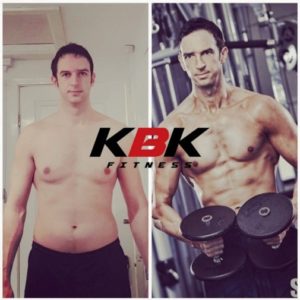
Kris Kane is a North Yorkshire based personal trainer, martial arts instructor and general fitness enthusiast. You can find him on Instagram at @koachedbykris and also view him professionally on LinkedIn at www.linkedin.com/in/kris-kane.
Last month I talked about how giving yourself a daily step goal can contribute to your fat loss progress. To quickly recap, a good starting point for general activity is 10k steps and you’d be surprised how far below this most office workers are who don’t already track it. Ramping this up if required can really help towards creating the energy deficit required for losing weight. Another big benefit to this is that it also forces you to get more fresh air, time away from the desk and can just be a great form of stress relief!
This is just one of several aspects that can be measured and then adjusted accordingly. Below are some more areas that if you start to regularly track can help paint a picture of the effectiveness of your routine and where you can improve going forward.
Nutrition
The underlying principle of fat loss is that the balance of energy in (from your food) needs to be less than your body uses. By tracking everything that passes your lips on an app like MyFitnessPal, you can get an idea how many calories you are consuming over a week to then establish a daily average.
The app has a built-in calculator which based on your stats can give you a deficit calorie target to aim for but this can sometimes be overly restrictive and doesn’t take certain factors into consideration. To keep it simple, I would advise starting off by just tracking your intake as it is for a week and see how your weight has changed. If you have gained, look at your logs and see where you can reduce calories. If your weight is the same then you are eating at maintenance so any reduction should then get the scales moving. If you have lost then great you are in a deficit, just keep going 🙂
The process of using a tracking app might also make you more mindful of the food choices you make when you can see how calorie dense certain foods or drinks are, which can certainly be surprising!
Once you are comfortable tracking you can start to look more closely at the makeup of your meals to better support your training, recovery and general healthy living.
Workouts
Have a structure to your workouts so when you hit the gym you know exactly what you are going to do and not just end up winging it. Having a solid plan in place will help keep you focused and make sure you are training all major body parts over the week.
Log your reps, sets and weights so over time you can see how you are performing. Every few weeks try and add in some form of progression, whether that is adding on extra reps, completing more sets or moving up a weight on exercises as they get easier.
Measurements
Scale weight alone isn’t always an indicator if you are losing body fat. Once a week, take your waist and hip measurements as this can also highlight fat loss which on occasions can be being masked by the scales for various reasons.
For more comprehensive information you could also take measurements from the widest point of your thigh, chest, upper arm and neck.
Progress photos
Every 2 weeks I encourage clients to take progress photos from the front, back and side so you can visibly see the changes to your physique. It can be very motivating when you start to see things such as the contour of your waist reduce or muscle definition becoming more prominent.
I hope the above gives you some ideas to think about. Good luck with your training and if anyone has any questions or is interested in some online coaching, feel free to drop me an e-mail at [email protected]
5 tips from someone who has kept the weight off (Lana Khazari)
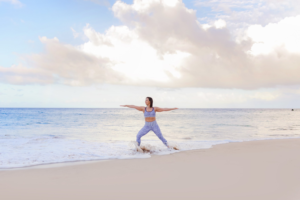
Lana Khazari is a Technical Support Analyst for the Corporation of City of Windsor, Ontario, Canada. She is also a Precision Nutrition Coach, Personal Trainer, Fitness Instructor and a Yoga 200-RYT Instructor. You can find her online soon at lanakharazi.com.
I always tried hard to do what I was supposed to do. That included finding a “career” that paid the bills and could set me up for the next step in life. Initially, I didn’t have much interest in computer programming or algorithms but I pulled off some pretty decent grades. And in the process, although I hated it at the beginning I learned to like it. I practiced and I got better. Then I even became good. I became proud of my nerd girl identity.
So, here’s me, almost 20 years ago…
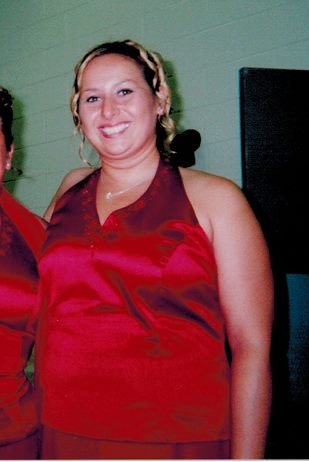
It’s the night before my first exam, almost midnight, and I’m at 7’Eleven filling up a slurpee cup and picking out gummy frog and banana candies. I fill a bag to fuel me for the all-nighter I need to pull. Every year, I procrastinate and panic during midterm and final exams. I don’t gain the freshman 15, I came in with that already. I didn’t exercise, I didn’t eat healthy. Hell, I didn’t even know what that looked like. I lived at home but hung out at my friend’s dorm most days where tater tots were the main meal of the day. I always slept in, missing all morning classes because I frequented Yahoo chatrooms and watched TV most nights. Some nights I partied and binge drank. I had a flexible campus job and made excuses to not show up after these nights. At the end of 4th year, I was big, real BIG and also really tired. A 20-something should never be that exhausted. I can’t tell you what my weight was, the scale was not my friend. The last number I saw was in the 230’s. I was struggling and miserable but did my best to laugh it off with friends.
Fast forward to today…
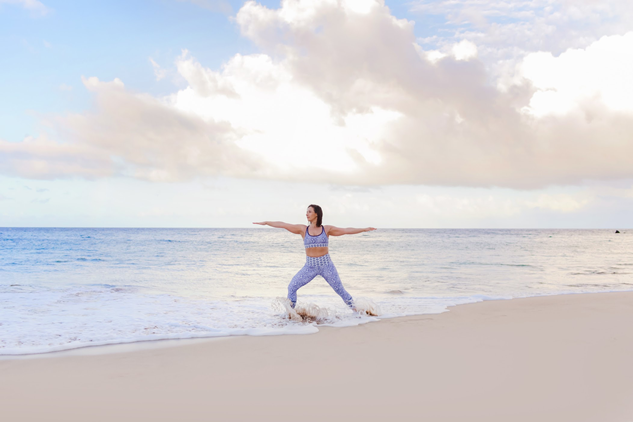
I go to bed early and wake up early. I have my meals prepped and ready for the work week. Before my current leave (just had a baby, yay!), I was up at 5 am and heading to the gym before work. The gym is my therapy and sets the tone for my entire work day. I lift a minimum of 4 times per week. On the day’s I’m not lifting, I’m training a client on how to lift. I head to my Tech job, and I put in a solid daily effort with a pretty good attitude. At 4:30, I head home, get dinner ready. We eat lots of veggies and whole foods. After dinner, I might have some client coaching calls for some nutrition consulting. I hang out with the hubby and then head to bed around 9. I also teach fitness classes, so I squeeze in 1 cycling or yoga class per week. Weekends are my time to hang out with family or friends or to do coursework. I’m always learning something. I’m full of energy and confident in my ability to figure most things out. I have routines, many of them. They help me thrive and also keep things steady. I’ve lost over 75 pounds and manage to have kept it off permanently.
It’s a complete 360 but it didn’t happen overnight. I’ve tried every diet out there. Cabbage Soup, Nutrisystem, Atkins and Weight Watchers a handful of times. Diets don’t work. I know what it is like to doubt yourself, to doubt the process, and doubt the whole diet industry. I’ve felt huge disappointments. I felt that even if I lost the weight, I’d probably gain it all back. I felt that everyone was always watching and judging.
For the longest time I thought that I was the failure, but what I’ve learned is I didn’t fail the diets, those diets failed me. And now I’m teaching others how to reprogram their habits to reach their goals.
A personal transformation takes work, consistency and time. I made A LOT of mistakes along the way and it took me years of making mistakes to learn what worked. So, let me help save you some time, grief and maybe even a lot of money by letting you know what you should NOT do:
- Don’t set a deadline
Do you want to lose 20 pounds for a wedding, a vacation or a reunion? Cut that out right now. Deadlines rarely lead to long-term change. Don’t starve yourself for 14 days and then binge for the next 10 because you’ve been depriving yourself and building pressure on yourself to get it done. Do you think about brushing your teeth? No. It’s automatic. It’s just what you do. So ditch the deadline and aim for small habit goals that will then become routine. These small habits become what you do and who you are.
- Don’t set a number goal like a scale weight or dress size
If you’re goal is to reach X-weight or X-dress-size, what happens? A week later you are trying to fit into those pants you bought two sizes smaller because “one day” and find out they still don’t fit. You might reject yourself immediately because you aren’t at goal yet. And you continue cycling between self-acceptance and self-rejection. It’s just an emotional roller coaster you don’t want to ride.
- Don’t be inflexible
We can’t help it when our kids get sick or important work deadlines suddenly appear. There me be a day we need to miss a workout. There might be other times where we forget our lunch, so we need to buy one. All-or-nothing thinking will easily help us sabotage all plans of exercise and instead driving through the nearest McD’s. We can’t help but have obstacles in our path. Inflexibility is a path to failure. Life happens. We have to adapt and learn how to respond in the best way possible.
- Don’t quit when things stall out
The road to success is never linear! You can’t just follow a diet and workout plan as outlined and expect that the path is always clear. Not only should you remain flexible but realize that there will be weeks where the numbers don’t move (although we shouldn’t be focusing on that, remember!). When we plateau, we can get impatient and think we need to do something different, don’t. Stay the course and accept that the path really looks like this:
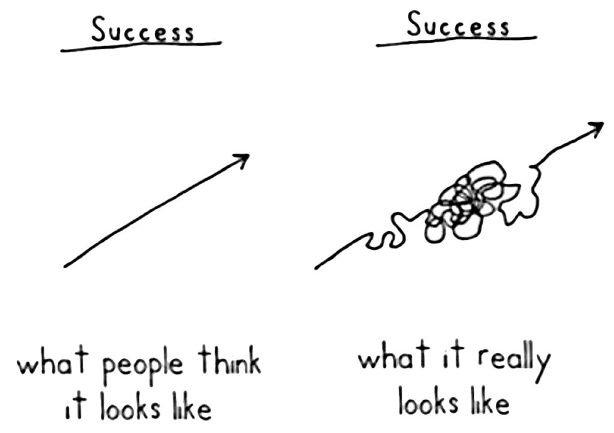
Brene Brown, a research professor and bestselling author, says it best,when perfection is driving, shame is in shotgun. If you aim for perfection, you’re never going to hit it.
- Don’t do it alone
Sustainability is built on strong social support. Tell your friends and family about your goals. It will make it harder to cave-in to that piece of cheesecake with them around. You want to be fitter? Surround yourself with “fit” people. There is a saying based on research that we are the sum of the 5 people we spend the most time with. Don’t even know where to start? Be resourceful and hire yourself a trainer, coach or even a therapist. Be accountable to someone other than yourself. Your support team can help you stay motivated and help reinforce behaviours that keep you on track
No change is easy. If the mental programs we operate with daily do not receive the latest updates, we are executing the same commands we did yesterday. This program runs in the background without us even being aware. We may get up late, give ourselves no time to pack a lunch and drive through for coffee and a donut on the way to work. You can see where this is going. But, it is possible to interrupt these processes and to create change.
If you have been dieting and failing, you may have lost your belief in your ability to succeed. Don’t throw in the towel. You don’t have to be a Vegan marathon runner to lose weight. You don’t even have to eat a perfectly healthy diet to lose weight. Instead, focus on the small habits and let the practice of those habits be the goal. It will be hard and you may hate it at first, but it’s the small changes and baby steps that lead to the big changes.
Send us your feedback!
Got feedback about anything in this issue of FitITproNews? Email us at [email protected] today!
The Toolbox
Join the premier virtual conference where we bring the latest and greatest in data protection, security and management directly to you – VeeamON Virtual
http://www.wservernews.com/go/f1yzq6si/
Motrix is a full-featured download manager that supports downloading HTTP, FTP, BitTorrent, Magnet, Baidu Net Disk etc.
7-Zip is an open source Windows utility for manipulating archives:
Open-Shell lets you use Start Menu and Explorer like it’s 2000: